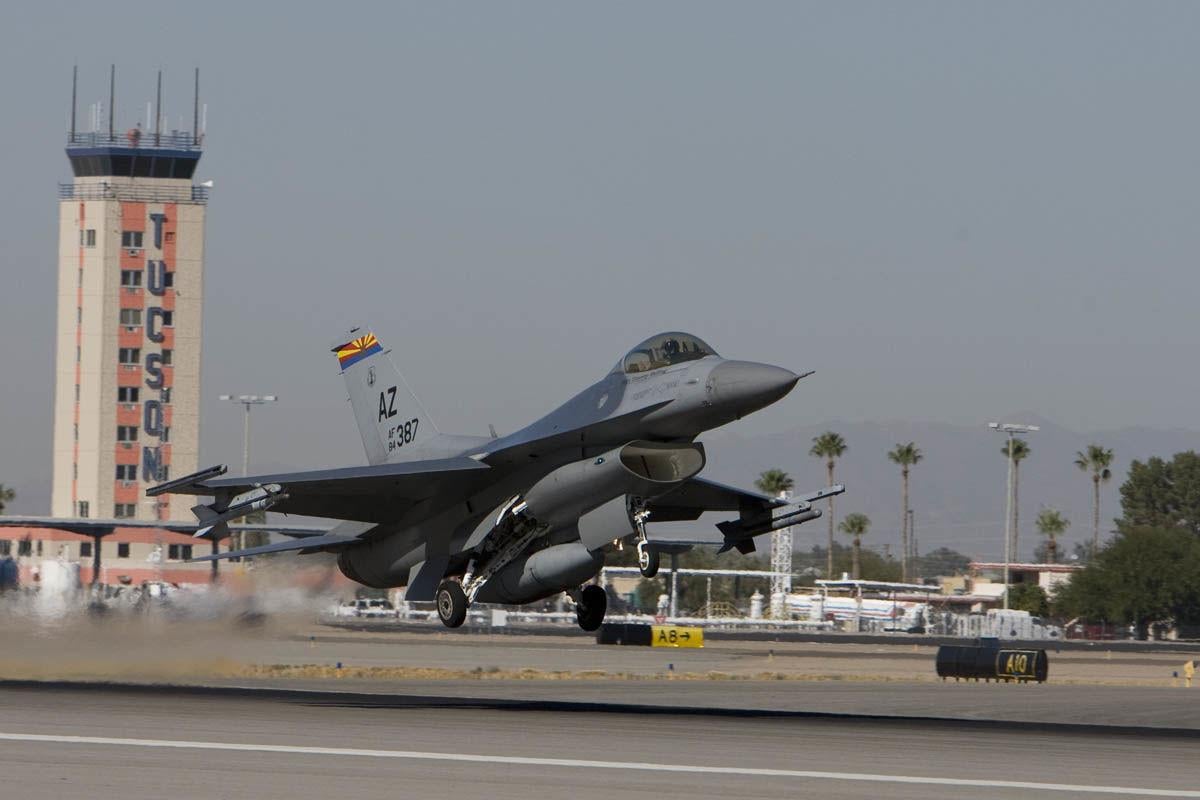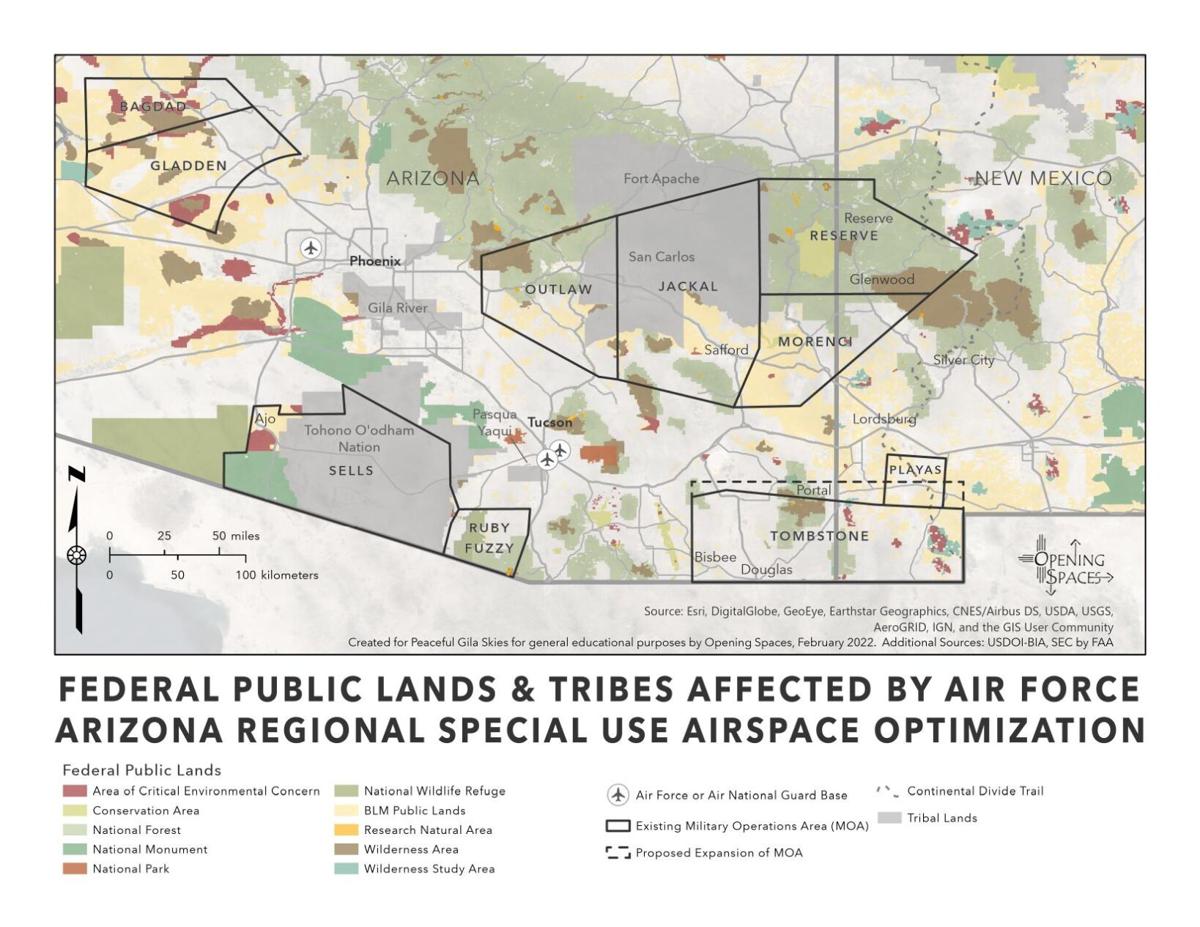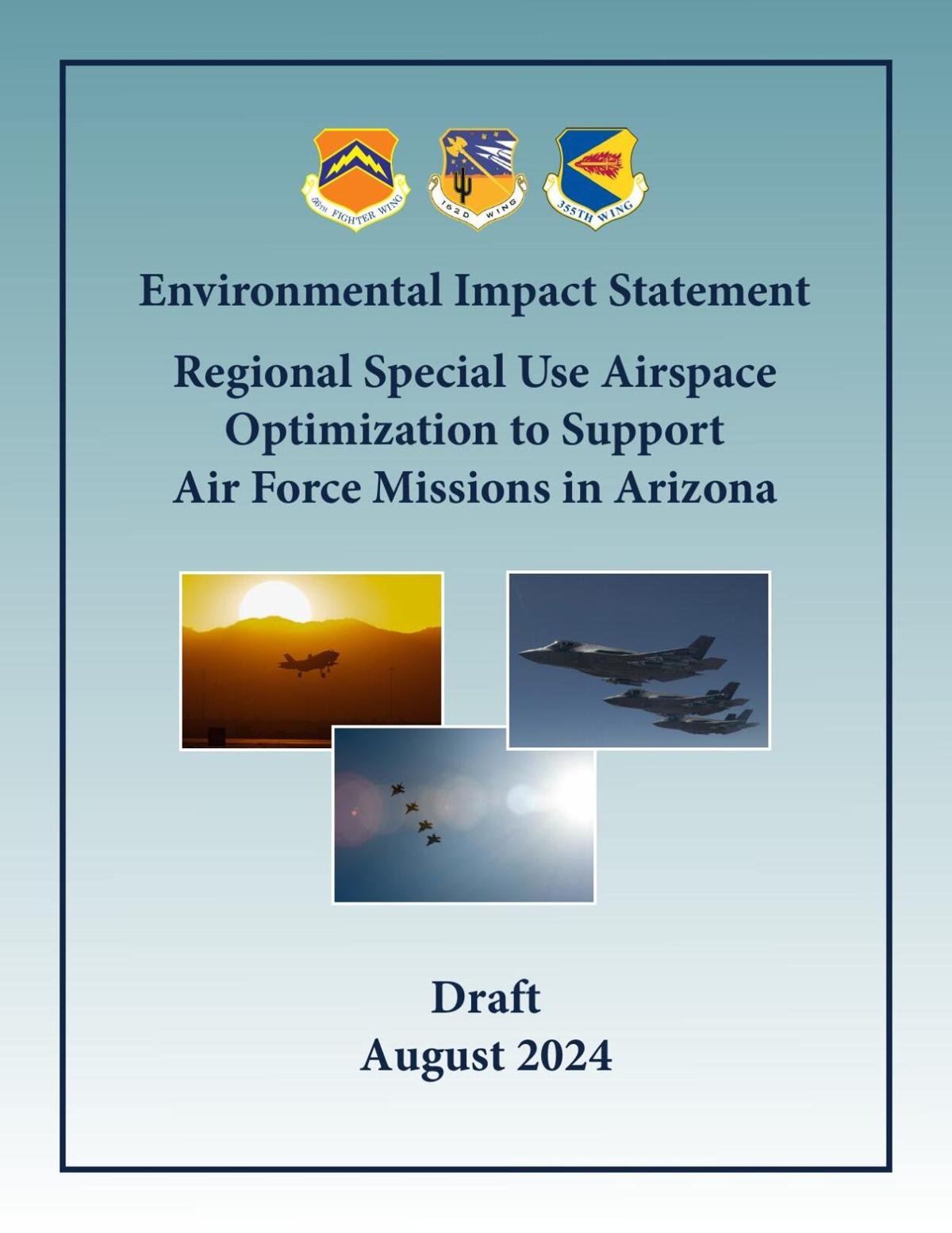The Air Force has released a draft study supporting proposed changes to flight rules over 10 military training airspaces across Arizona and New Mexico, including allowing lower-altitude supersonic flights and longer nighttime flying hours, and expanding one training zone in the southeast corner of the state.
The public can view and comment on the Draft Environmental Impact Statement for the Regional Special Use Airspace Optimization in Arizona online at arizonaregionalairspaceeis.com, with comments accepted through Oct. 9.
The Air Force has scheduled a series of public hearings on the draft environmental statement from late August through mid-September in Ajo, Bagdad, Morenci and Superior, as well as four New Mexico communities, with virtual hearings scheduled for Sept. 4 and 5. A hearing schedule is also available at arizonaregionalairspaceeis.com.
The draft statement is similar to an initial proposal unveiled in 2022 and discussed at a series of public scoping meetings.
The Air Force says it has received more than 6,600 comments from the public, state and local government agencies, tribes, aviation groups and nonprofits, including many that have cited safety, health and environmental concerns.
The service says the changes to the special-use airspaces called Military Operations Areas, or MOAs, are needed to optimize training conducted by units at Davis-Monthan Air Force Base, the Morris Air National Guard Base at Tucson International Airport and Luke Air Force base near Phoenix.
The proposed changes would affect the adjacent Sells, Ruby and Fuzzy MOAs, stretching southwest of Tucson from Interstate 19 to near Ajo; the Tombstone MOA, which covers the southeast corner of Arizona and southwest corner of New Mexico; the adjacent Bagdad and Gladden MOAs northwest of Phoenix; and the Outlaw, Jackal, Morenci and Reserve MOAs, which together stretch across a huge swath of east-central Arizona into New Mexico.
In its preferred alternative, the Air Force has proposed adjusting the “published times of use” for all of the affected MOAs, partly to eliminate some of the temporary “notices to airmen” that the Air Force now routinely issues for night training.
Among other changes in the Air Force’s proposed alternative, the plan would:
- Authorize supersonic flight speeds down to 5,000 feet above ground level in the Tombstone, Outlaw, Jackal, Morenci and Reserve MOAs, from 30,000 feet above sea level now;
- Extend the northern boundary of the Tombstone MOA, which spans the southeast corner of Arizona and the southwest corner of New Mexico to the Mexican border, adding about 750 square miles;
- Lower the flight floor of the Tombstone MOA to 100 feet above ground level and lowering the floors of Outlaw, Jackal, Bagdad and Gladden MOAs to 500 feet;
- Authorize the use of chaff — metallized filaments launched from aircraft to confuse enemy radar — for the first time in the Tombstone MOA;
- Lower the minimum altitude for releasing flares, launched to defeat heat-seeking missiles, in the Tombstone, Outlaw, Jackal, Bagdad and Gladden MOAs to 2,000 feet.
The plan has attracted opposition from residents in the affected areas that cite potential health and safety impacts from lower-level, supersonic flights, the environmental effects of training including pollution from chaff releases and the danger of wildfires from flares, though the Air Force says they burn out long before reaching ground.
In May, the Center for Biological Diversity sued the Air Force under the Freedom of Information Act for failing to release public records about the proposed expansion of military flights, noting that the proposal would affect millions of acres of the Gila Wilderness and other public lands in southeast Arizona and southwest New Mexico.
Peaceful Chiricahua Skies, a nonprofit group with members in Arizona and New Mexico, is concerned with impacts on the Chiricahua Mountains and Chiricahua National Monument area in Cochise County — partly covered by the Tombstone MOA.
The group said the latest plan enumerates a major rise in overall flights, including an increase from 3,450 to 8,000 average annual sorties, or round-trip flights, in the Tombstone MOA alone.
Overall, the Air Force is proposing to increase its annual flight-training sorties by about 37%, from a current average of about 38,000 over all the MOAs to a proposed 52,000 annually.
“This DEIS (Draft Environmental Impact Statement) will be a great disappointment to the many concerned citizens who previously submitted comments opposing the expansion of high-decibel, low-level training flights over residential, commercial and wild areas of southeast Arizona and southwest New Mexico,” said Karen Fasimpaur, a volunteer with Peaceful Chiricahua Skies.
Fasimpaur also faulted the Air Force for failing to schedule one of the upcoming public hearings in Cochise County, despite the potential impacts there.
Peaceful Chiricahua Skies and another group, Peaceful Gila Skies, also submitted petitions in opposition to the Air Force plan, along with a small air park northwest of Phoenix.
The Air Force statement found no significant environmental or socioeconomic impacts from its proposed action.
The Air Force rejected two alternative proposals that mostly mirrored the preferred plan, except that one would keep the current Tombstone MOA without expansion and the other would have allowed supersonic flight down to only 10,000 feet.
Performers get in a day's worth of rehearsals before the weekend's Thunder & Lightning Over Arizona at Davis-Manthan Air Force Base, March 24, 2023. Video Kelly Presnell / Arizona Daily Star







